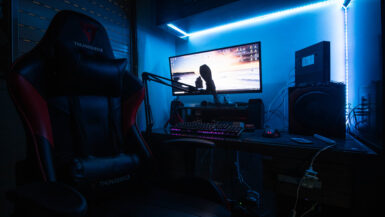In today’s fast-paced world, voice-enabled smart home devices have become an integral part of modern living, offering an unparalleled level of convenience and control. One area where this technology truly shines is in the seamless integration of voice control with your smart home’s window treatments. In this comprehensive guide, we will be diving deep into the core aspects of this innovative solution, including the various types of smart window treatments available, choosing the right voice assistant, compatibility considerations, and step-by-step instructions for effortless integration. Join us as we unlock the full potential of voice-controlled window treatments, and transform your home into an epitome of comfort, efficiency, and sophistication.
Top Voice Assistant Options for Smart Window Treatments
In this section, we will explore some of the best voice assistant options available for integrating with your smart window treatments. These voice assistants not only offer exceptional performance and compatibility but also provide a wide range of features that enhance the overall user experience. Let’s delve into the top contenders in the voice assistant market and their unique offerings to help you make an informed decision.
Amazon Alexa: A Popular Choice for Smart Home Integration
Amazon’s Alexa is a widely-used and versatile voice assistant that seamlessly connects with various smart home devices, including window treatments. With an extensive range of compatible devices and a user-friendly interface, Alexa allows you to effortlessly control your smart blinds, shades, or curtains using simple voice commands. Additionally, the Alexa ecosystem offers a vast selection of compatible smart home products and third-party integrations, making it easier for you to create a cohesive smart home experience.
Google Assistant: Harnessing the Power of Google’s Ecosystem
Google Assistant is another popular choice for smart home enthusiasts, offering a robust platform for voice control and automation. Known for its ability to understand complex commands and deliver accurate responses, Google Assistant provides a seamless voice control experience for your smart window treatments. With support for an impressive range of devices and brands, this voice assistant can effortlessly integrate with your existing smart home setup, allowing you to leverage its powerful features and enjoy the convenience of hands-free control.
Apple HomeKit and Siri: Catering to the Apple Ecosystem
For those who are heavily invested in Apple products, the combination of HomeKit and Siri offers a reliable and intuitive voice control solution for your smart window treatments. Apple HomeKit allows you to create custom scenes and automations for your smart devices, while Siri enables you to execute these actions using simple voice commands. While the range of compatible devices may be narrower compared to Alexa and Google Assistant, the tight-knit integration with other Apple products ensures a cohesive and secure smart home experience.
Cortana: Microsoft’s Voice Assistant for a Connected Home
Although not as popular as the other options on this list, Microsoft’s Cortana is a capable voice assistant that can be used to control your smart window treatments. With support for a variety of smart home devices and platforms, Cortana offers a convenient and straightforward way to manage your window coverings using voice commands. If you are a user of Microsoft products and services, integrating Cortana into your smart home setup can be a viable option.
Ultimately, the choice of which voice assistant to use for your smart window treatments depends on factors such as your existing smart home ecosystem, device compatibility, and personal preferences. Each of these voice assistants offers unique features and benefits, making it essential to evaluate their capabilities and compatibility with your smart window treatment devices before making a decision.
Step-by-Step Guide to Setting Up Voice Control for Smart Blinds
Integrating voice control with your smart home’s window treatments can seem daunting, but with the right guidance, it’s a breeze. This step-by-step guide will walk you through the process of setting up voice control for your smart blinds. We will cover everything from selecting the right smart blinds and voice assistant to pairing devices and configuring voice commands, ensuring a seamless integration experience.
Choose the Right Smart Blinds and Voice Assistant
Before diving into the setup process, it’s essential to select the right smart blinds and voice assistant that best suit your needs and preferences. Ensure that your chosen smart blinds are compatible with your preferred voice assistant, such as Amazon Alexa, Google Assistant, Apple HomeKit and Siri, or Microsoft Cortana.
Install and Set Up Your Smart Blinds
Follow the manufacturer’s instructions to correctly install your smart blinds. Once installed, ensure that the smart blinds are connected to your home Wi-Fi network and that you have downloaded the corresponding mobile app to control and configure the blinds.
Connect Your Voice Assistant to the Smart Blinds
To enable voice control, you’ll need to link your voice assistant to the smart blinds. This process may vary depending on the voice assistant you’re using, but it typically involves the following steps:
1. Open your voice assistant’s app (e.g., Amazon Alexa, Google Home, Apple Home, or Cortana).
2. Add a new device by selecting the “+” icon or the “Add Device” option.
3. Choose the smart blind’s manufacturer from the list of available devices.
4. Follow the on-screen instructions to complete the pairing process, which may include signing in to your smart blinds account and granting permissions.
Configure Voice Commands and Personalize Your Experience
Once your voice assistant is connected to your smart blinds, it’s time to set up voice commands and customize your voice control experience. Most voice assistants allow you to create custom names for your smart blinds, making it easier to remember and use voice commands. For instance, you could name your living room blinds as “Living Room Blinds” and your bedroom blinds as “Bedroom Blinds.”
With custom names in place, you can now use voice commands such as “Hey Google, close the Living Room Blinds” or “Alexa, open the Bedroom Blinds.”
Additionally, you can create routines or scenes that involve your smart blinds, allowing you to control multiple devices simultaneously. For example, you can create a “Good Morning” routine that opens your blinds, turns on your lights, and starts your coffee maker, all with a single voice command.
Test Your Voice Control Setup and Troubleshoot If Necessary
Ensure that your voice assistant responds accurately to your commands by testing the setup. If you encounter any issues or your voice assistant doesn’t recognize your commands, check your device compatibility, Wi-Fi connection, and settings in both the smart blinds app and the voice assistant app. If problems persist, consult the user manuals or contact customer support for assistance.
Following these steps will help you successfully integrate voice control with your smart home’s window treatments, enhancing your home’s functionality and convenience. Embrace the power of voice control and enjoy the ease of managing your smart blinds with just a few words.
Exploring Compatible Smart Window Treatment Brands and Products
When it comes to integrating voice control with your smart home’s window treatments, choosing the right brand and product is crucial. This subsection will dive into some of the leading brands and products in the smart window treatment market, highlighting their compatibility with popular voice assistants and unique features. By understanding the offerings of these brands and their products, you can make an informed decision that best suits your needs and preferences.
Lutron: A Pioneer in Smart Lighting and Window Treatments
Lutron is a well-established brand in the world of smart home automation, known for its innovative lighting and window treatment solutions. Their Serena Smart Shades are an excellent choice for those looking to integrate voice control with their window treatments. These shades are compatible with Amazon Alexa, Google Assistant, and Apple HomeKit, making them a versatile option for a seamless smart home experience. With Lutron’s Caséta Wireless system, you can easily create schedules, scenes, and automations for your Serena Smart Shades, offering a high level of customization and convenience.
Hunter Douglas: Luxury and Innovation Combined
Hunter Douglas is a leading brand in the window treatment industry, offering a wide variety of high-quality and stylish products. Their PowerView® Motorization system is a cutting-edge solution for smart window treatments that can be easily integrated with voice control. Compatible with Amazon Alexa, Google Assistant, and Apple HomeKit, the PowerView® Motorization provides a seamless and intuitive voice control experience. With the PowerView® app, you can create custom scenes and automations, allowing you to operate your window treatments effortlessly.
Somfy: A Global Leader in Motorized Window Coverings
Somfy is a renowned brand in the world of motorized window coverings, offering a range of products equipped with their innovative motorization technology. Somfy’s motorized blinds, shades, and curtains can be easily connected to their TaHoma smart home hub, enabling voice control compatibility with Amazon Alexa and Google Assistant. This integration allows you to control your window treatments with simple voice commands, while also offering the flexibility of creating scenes and schedules through the TaHoma app.
ikea: Affordable Smart Window Treatment Solutions
Ikea, a popular choice for budget-conscious consumers, also offers smart window treatment options that can be integrated with voice control. Their FYRTUR and KADRILJ smart blinds work with the Ikea Home Smart (TRÅDFRI) system and are compatible with Amazon Alexa, Google Assistant, and Apple HomeKit. These blinds offer an affordable and user-friendly solution for those looking to add voice control to their window coverings without breaking the bank. With the Ikea Home Smart app, you can easily set schedules and control your blinds using voice commands, providing a convenient and accessible smart home experience.
By exploring the offerings of these reputable smart window treatment brands and their products, you can find the perfect solution for integrating voice control with your smart home’s window coverings. Consider the compatibility with your preferred voice assistant, the features offered, and your budget to make the best choice for your home. With the right product in place, you can enjoy the unparalleled convenience and sophistication that voice-controlled window treatments bring to your smart home.
Advanced Voice Command Techniques for Smart Window Coverings
Integrating voice control with your smart home’s window treatments can significantly enhance convenience and functionality. While basic voice commands can help you achieve simple tasks like opening and closing your blinds, there are advanced voice command techniques that can unlock a higher level of control and customization. In this subsection, we will explore these advanced techniques, including creating custom phrases, using conditional commands, and incorporating window treatments into multi-device routines. By mastering these advanced techniques, you can elevate your smart home experience and enjoy the full potential of voice-controlled window coverings.
Creating Custom Phrases for Window Treatment Control
Most voice assistants allow you to create custom phrases or shortcuts to control your smart window coverings more efficiently. By assigning a specific phrase to a particular action, you can personalize your voice command experience and make it easier to remember and use. For example, instead of saying, “Hey Google, close the Living Room Blinds,” you could create a custom phrase like, “Hey Google, it’s movie time,” which would automatically close the blinds for an ideal movie-watching environment.
Using Conditional Commands for Enhanced Control
Conditional commands are an advanced voice command technique that allows you to execute actions based on specific conditions or triggers. These commands enable a higher level of customization and can help you automate your window treatments more effectively. For example, you could set up a conditional command like, “Hey Siri, close the blinds when the temperature exceeds 80 degrees,” which would automatically close your blinds when the temperature reaches the specified threshold.
Incorporating Window Treatments into Multi-Device Routines
Voice assistants offer the ability to create routines or scenes that involve multiple smart devices, allowing you to control several devices simultaneously with a single voice command. By incorporating your smart window coverings into these routines, you can streamline your daily tasks and create a more cohesive smart home experience. For instance, you can create a “Good Night” routine that lowers your blinds, turns off your lights, and adjusts your thermostat, all with a single command like, “Alexa, good night.”
Utilizing Voice Assistant Skills or Actions for Additional Functionality
Some voice assistants also offer additional skills or actions that can enhance the functionality of your smart window treatments. These skills or actions can be enabled through your voice assistant’s app and may provide unique features, such as voice feedback on the current blind position or the ability to control your window coverings based on the sunrise and sunset times. Exploring these additional capabilities can help you make the most of your voice-controlled window treatments and further optimize your smart home setup.
By mastering these advanced voice command techniques, you can unlock the true potential of your smart home’s window treatments, providing unparalleled convenience and control. Embrace these techniques to create a tailored voice control experience that perfectly aligns with your lifestyle and preferences, while enjoying the benefits of a seamlessly integrated smart home environment.
Common Troubleshooting Tips for Voice-Enabled Window Treatments
Integrating voice control with your smart home’s window treatments can be a seamless and rewarding experience. However, occasionally, you may encounter challenges or issues that hinder the functionality of your voice-enabled window coverings. In this subsection, we will discuss some common troubleshooting tips that can help you quickly resolve any issues and get your voice-controlled window treatments back on track. These tips will cover various aspects, such as connectivity, voice command recognition, and device compatibility, ensuring you have the tools and knowledge needed to address any problems that may arise.
Resolving Connectivity Issues
One of the most common issues with voice-enabled window treatments is related to connectivity. If you find that your voice assistant is not responding to your commands or is unable to control your window coverings, it’s essential to check your Wi-Fi connection. Ensure that both your smart window treatment device and your voice assistant are connected to the same Wi-Fi network. If you still face connectivity issues, try restarting your router and devices to see if that resolves the problem.
Improving Voice Command Recognition
If your voice assistant is having difficulty understanding your commands or is not executing the desired actions, it’s crucial to ensure you’re using the correct voice command syntax. Consult your device’s user manual or the voice assistant app for the appropriate command structure. Additionally, you can try speaking more clearly and slowly to improve recognition. In some cases, background noise may interfere with your voice commands, so ensure you’re in a quiet environment while issuing commands to your voice assistant.
Addressing Device Compatibility Concerns
Device compatibility is another common concern when it comes to voice-enabled window treatments. Ensure that your smart window treatment device is compatible with your chosen voice assistant. If you’re unsure, refer to the manufacturer’s website or user manual for compatibility information. If your devices are compatible but still not functioning correctly, try updating the firmware on both your smart window treatment device and your voice assistant, as outdated software may cause compatibility issues.
Resetting and Reconnecting Devices
Sometimes, a simple reset and reconnection can resolve issues with your voice-enabled window treatments. If you’ve tried the above troubleshooting tips and your devices are still not functioning correctly, consider resetting your smart window treatment device and your voice assistant to their factory settings. Once reset, follow the manufacturer’s instructions to reconnect and pair the devices. This process may resolve any lingering issues and restore the functionality of your voice-controlled window coverings.
Reaching Out to Customer Support
If you’ve exhausted all troubleshooting options and your voice-enabled window treatments are still not functioning as expected, don’t hesitate to contact the customer support team of the device manufacturer or your voice assistant provider. They can provide expert guidance and assistance to resolve your issues, ensuring you can enjoy the convenience and benefits of voice-controlled window coverings in your smart home.
By implementing these troubleshooting tips, you can address and resolve common issues with voice-enabled window treatments, ensuring a smooth and enjoyable user experience. Keep these tips handy to tackle any challenges that may arise, and continue to enjoy the convenience and sophistication that voice-controlled window coverings bring to your smart home.





Leave a reply